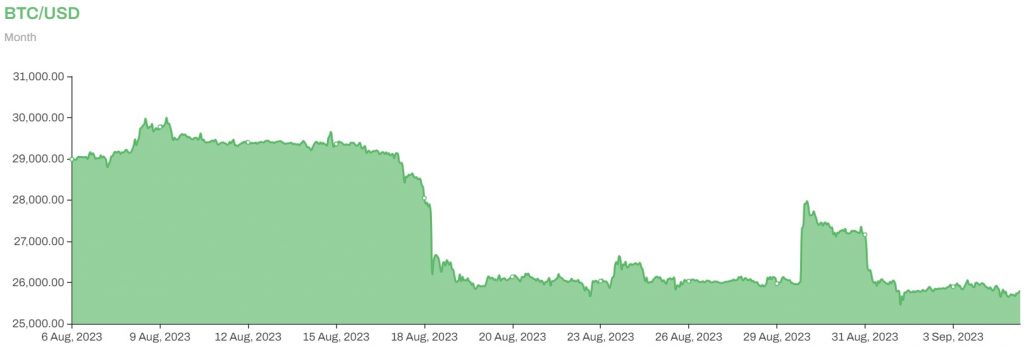In a surprising turn of events, Bitcoin and other risk assets appear to be defying conventional economic wisdom. Despite the Federal Reserve embarking on its most aggressive interest rate hike cycle in decades, Bitcoin’s value has not only held steady but has doubled since the last major cryptocurrency exchange collapse. This intriguing relationship between Bitcoin and interest rates was elucidated by Arthur Hayes, the founder of BitMEX and current Chief Investment Officer at Maelstrom, during his keynote at Korea Blockchain Week.
A Departure from the Norm
Traditionally, an increase in interest rates by the Federal Reserve should have sent shockwaves through financial markets, leading to a decline in the value of risk assets like Bitcoin and tech stocks such as Nvidia. However, this time, things seem to be different.
Economists who had initially predicted a recession are now revising their forecasts, while Bitcoin remains resilient. This break from the norm suggests that a new economic paradigm might be emerging.
Unintended Consequences
In his keynote at Blockchain Week, Hayes posits that the Federal Reserve’s decision to raise interest rates as a measure to combat inflation has had unintended consequences. While such rate hikes are intended to control inflation, they can also stagnate the prices of financial assets.
This, in turn, reduces capital gains taxes and government revenue, potentially worsening deficits. In response to these deficits, the US Treasury issues more bonds, leading to increased interest payments to the wealthy, which, paradoxically, stimulates spending and nominal GDP growth.
Cryptocurrency’s Resilience
Despite the changing economic landscape, Hayes is optimistic about the cryptocurrency industry’s future. He asserts that regardless of whether the Fed continues to raise rates or decides to cut them, the cryptocurrency sector is well-positioned to thrive.
This resilience suggests that cryptocurrencies like Bitcoin have evolved beyond the traditional economic indicators that once influenced their value.
As of September 5 noon, Bitcoin is trading at around $25.7K, which is down by 0.40% from the previous day. It may be a far cry from its all-time high of $68,990.90 two years ago but it’s sitting somewhere in between its 52-week low and high between $15,480 and $31,809.12.

The Rise of AI Companies
Hayes also highlights the increasing significance of artificial intelligence (AI) companies in the current economic climate. These companies, characterized by substantial cash reserves and robust revenue streams, are less dependent on traditional banks for loans or credit.
The American entrepreneur predicts that the global government bond market may be the one to face defaults if central banks resort to extensive money printing, which could strain the banking system.
Filecoin’s Potential
One cryptocurrency that stands to benefit from the intersection of AI and crypto is Filecoin (FIL). Hayes believes that Filecoin is well-positioned for growth due to the expansion of computational power within its network.
While it has experienced hype cycles and market fluctuations, the increasing amount of computational power, measured in PetaFLOPS, being added to its network bodes well for its future prospects.
Caution Amidst the Mania
Hayes cautions, however, that investing in AI companies may not yield immediate returns. Many of these companies are currently overvalued, have protracted timelines to IPOs, or enforce long token lockup periods.
Additionally, some may struggle with a poor product-market fit, boasting a high number of users but a low number of paying subscribers. Consequently, retail investors may need to exercise patience before realizing significant returns.
The Brewing Asset Bubble
In closing, Hayes warns of a looming asset bubble fueled by the convergence of three manias: AI, cryptocurrencies, and money printing. These three factors together could potentially create the most significant asset bubble in nearly eight decades, comparable to the Great Depression of the 1930s.
Final Thoughts
In a world where traditional economic indicators no longer seem to apply, the evolving relationship between Bitcoin, interest rates, and other risk assets raises intriguing questions about the future of finance. As the cryptocurrency and AI sectors continue to grow, investors must navigate this shifting landscape with caution and foresight while keeping in mind the insights shared by Arthur Hayes.
Giancarlo is an economist by profession with a career spanning nearly two decades. His professional journey has seen him assume vital roles in various government and private organizations such as the Department of the Interior and Local Government (DILG), the National Economic and Development Authority (NEDA), Megaworld Corporation, and the China Banking Corporation in the Republic of the Philippines.
In addition to his civic and corporate pursuits, his forward-thinking approach has led him to manage several prominent websites in the banking and finance sector, notably the Australia-based RateChoice, where he immersed himself in the world of emerging financial technologies and where he found particular interest in Bitcoin all the way back to 2013.
Prior to his addition to Blockzeit’s dynamic team, he held an essential role as Project Manager for initiatives encompassing blockchain, stablecoin, mining, special economic zone development, and iGaming. This noteworthy chapter in his career unfolded under the auspices of InPlan Consultancy Services, Inc., the think-tank of IMPERO Consortium Management Corporation headquartered in Manila, Philippines, and Tokyo, Japan. InPlan, led by a distinguished retired Cabinet member of the Philippines, collaborates directly with IMPERO’s core management team, contributing to strategic planning and business development endeavors.












